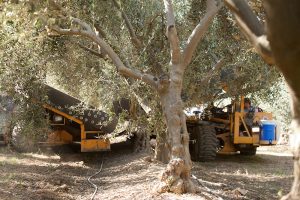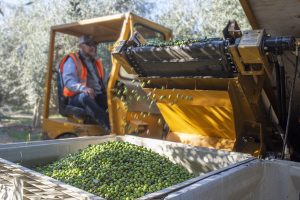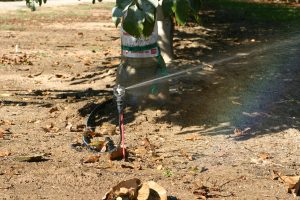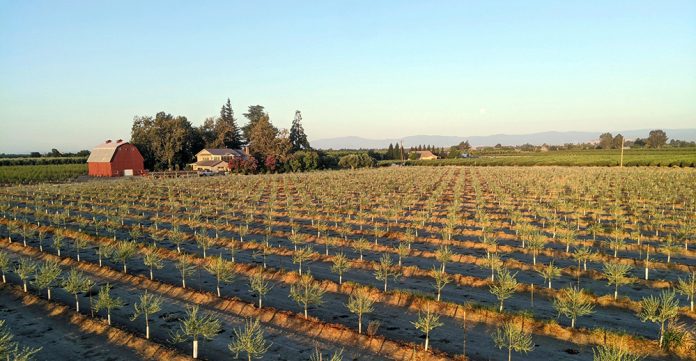What can growers do to insulate themselves against water shortages, increased input costs and decreasing nut prices? Diversification into crops that are less water- and input-intensive could be a safety net for growers.
The standard for determining profitability used to be how much per acre a crop produced, but that may not be the gold standard any longer. Making the most money per acre, regardless of how much water and fertilizer the crop requires, might not be the most profitable when growers look at their bottom line.
Diversification
Looking at the net profit per unit of water, olives might be the most profitable right now, especially with limited water. The better method to calculate profit might be by the acre-foot of water required to grow the crop and the amount of other inputs.
Cliff Beumel, president of Agromillora California Nursery, believes olives have the potential as a diversification crop, and he said there’s opportunities in orchards for both olive oil and for table olives.
Olives also have minimal inputs for pests and diseases when compared to other tree crops, and they require less fertilizer than nuts crops as well. “Drastically less fertilizer,” Beumel said, adding olives require much lower inputs across the board.
“When you start analyzing crops from that perspective, not just what is my revenue, or my net profit per acre, and you start looking at what is my profit per unit of water, olives look very, very good right now, maybe better than any of the big crops,” Beumel said, adding olives compared to nuts are probably making more money.
Table Olives
Dennis Burreson vice president of field operations and industry affairs for Musco Family Olive Company offered several benefits for growing table olives:
- They use less water
- They grow well in a wide range of soils
- They have minimal pests and disease
- They are mechanically harvested, pruned and topped
Compared to almonds, walnuts and pistachios, which have several pests and diseases, olives have minimal problems. Olive Fruit Fly (OLFF) is the main pest, and there are chemical treatments for controlling it. The main disease is olive knot, which is managed with copper treatments.
Musco is offering free Manzanillo trees to growers interested in planting a minimum of 40 acres configured for mechanical harvest, and long-term contracts.
“We’re suggesting, tighter plantings, 18×10, 18 feet between rows, 10 feet between trees. That’ll give you 242 trees per acre. But there’s flexibility in that, depending on your soils, and depending upon the lay of your land, 18×12 works or 20×10,” Burreson said, adding they feel it’s important to get the tree count over 200 trees per acre.
About half of Musco’s trees are either in the ground or committed. “So, we’re moving along and feel good about it,” Burreson said, adding our goal is to make table olives the crop of the future in California.
For more information go to milliontrees.com or contact Burreson directly at 530-624-4475.
Less Water
Reduced water consumption is usually the first thing that attracts growers to olives; half as much water is generally the rule, Beumel said. “If you’re using two acre-feet of water to grow super high-density hedged olives for oil, you’re probably wasting a half an acre-foot of water. Some of the best growers are able to use 1.5 acre-feet of water and get excellent yields on oil olives.”
Olives aren’t finicky with soil or salt content. Some of the largest olive oil orchards have been in ground so marginal that no other crops grow there, Beumel said.
Olives will grow well in all soils, too, but they will need even less fertilizer and water because of the natural benefits of the soil. Too much water and fertilizer will result in no crop, Beumel said.
“Oil olives require very, very minimal water and fertilizer in order to get the highest yields,” Beumel said.
Irrigation Research
Giulia Marino is an extension specialist in orchard systems at UC Davis and Kearney Agriculture Research and Extension Center, and she’s conducting irrigation research on water usage for table and oil olives and how much water stress they can withstand. In the north, there are two orchards in the project in Corning and Orland. The third site is close to Stockton. Each orchard has different types of soil and management.
“I think this project will help growers to improve their irrigation management by developing precise and updated information on olive orchard water use. It also explores the possibility to manage irrigation measuring tree water status. Each orchard is different, and for a precise management of irrigation, you want to know the value of the stress of your trees,” Marino said.
“The best method to do this is using stem water potential, which is a very good indicator in olive,” Marino said.
Marino is also testing some new sensors that were released a couple of years ago that are providing very promising results in almond and other crops.
“We are using sensors that can measure stem water potential and are placed directly in the trunk of the trees,” she said, adding this sensor would be an alternative for having to go into the orchard to take stem water potential readings.
Marino is in the first year of the research, and she will have more definitive findings next year.

Mechanical Harvest Research
In the past, a major drawback for growing olives has been hand harvesting and pruning. That has changed. Table and oil olives are mechanically pruned with some hand pruning and mechanically harvested. Oil olives have shown the benefits of higher-density planting, according to Louise Ferguson, extension specialist in the Department of Plant Science at UC Davis.
Ferguson has been doing mechanical olive harvest research for over 20 years. Last year, she did research using a trunk shaker on table olive trees pruned for trunk shaking, 15- and 20-year-old trees. They were topped at 12 feet and hedged at four to six feet from the trunk, every other year, and topped every year.
“We got 80% removal with the trunk shaker,” Ferguson said.
If there’s a five-ton crop and the shaker removes four tons, it makes financial sense to send a hand crew in to harvest the last ton because it shouldn’t take more than a step stool to reach the remainder, Ferguson said.
“The pistachio style double-sided trunk shaker is doing an effective job if you can shake at the appropriate time on table olives. We are still working on an efficient [abscission] agent to increase that efficiency,” Ferguson said, adding an abscission agent would be applied to loosen the fruit prior to harvest.
Conceivably, a pistachio grower interested in diversifying with table olives could use the same harvest equipment on olives and pistachios, Ferguson said.
“And actually, you can use the same mechanical pruning too, because I have worked with hedging and topping of oil and/or table olives, and you can use the same topper and hedger, and it’s basically almost the same schedule as for pistachios,” Ferguson said.
It’s important to top every year, especially for table olives because the fruit at to the top of the tree ripens earlier, which puts more overripe olives in the bin. Those olives are downgraded as overripe for the California black ripe processing, Ferguson said.
Ferguson and Professor Reza Ehsani, at UC Merced, are doing research on a canopy contact shaker. “We’re working on a canopy contact plus trunk shaker combined,” she said, adding this shaker would only work with new plantings.
The bottom line: for new plantings of olives, mechanical harvesting equipment is available and effectively removes the fruit, Ferguson said.
While table olives are using trunk shaking of some type, oil olives in super high-density hedges have been harvested with “over-the-row” harvesting machines for more than two decades now, Beumel said. These machines are well-proven and used across the globe. Similar harvesters are used to harvest wine grapes, blueberries, coffee and other major crops, he added.

Dryland
Arbosana, Arbequina and, to a lesser extent, Koroneiki, have been the go-to oil varieties for super high-density plantings. But Lecciana, a new hybrid oil variety (a cross of Arbosana and the famous Italian variety Leccino) from University of Bari in Italy, is being widely planted in Spain and around the Mediterranean. Lecciana has good vigor, improved agronomic traits like cold tolerance and resistance to disease, and excellent oil quality.
“In the south of Spain, we have growers who are dry farming Lecciana,” Beumel said.
They are using water from winter and spring rains and getting 60% to 70% yields of conventionally grown oil olives by taking advantage of the Lecciana variety’s vigor and growing them in a hedgerow.
“You can actually grow olives, almost dryland, even in the south of Spain, which is just as dry as California, and get yields. And so, if you’re looking at buying water versus not buying water, which is how growers have to think now, you can think very far out of the box,” Beumel said.

International Sales
Another key piece of diversification that growers don’t consider are international sales, Beumel said. “Every nut grower knows that a big part of their returns come from the international sales of the nuts. But that brings in world competition, it brings the shipping, logistics, the ports, the exchange rate from a weak dollar, a strong dollar, all that stuff.”
In comparison, California supplies less than 10% of the olive oil used in the U.S., and as olive oil use continues to increase, more and more olive oil will be sold domestically, Beumel said. Therefore, by diversifying with table and/or oil olives, growers don’t have all the concerns and risks that come with international sales. And that is another important aspect of diversification.











